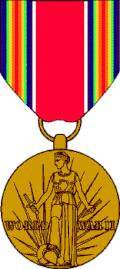World War II Victory Medal
| World War II Victory Medal | |
|---|---|
 World War II Victory Medal | |
| Type | Medal |
| Eligibility | served in the armed forces between the following dates:
|
| Status | Inactive |
| Precedence | |
| Next (higher) | European-African-Middle Eastern Campaign Medal |
| Next (lower) | Army of Occupation Medal or Navy Occupation Service Medal |
The World War II Victory Medal is a decoration of the United States military which was created by an act of Congress in July 1945. The decoration commemorates military service during World War II and is awarded to any member of the United States military, including members of the armed forces of the Government of the Philippine Islands, who served on active duty, or as a reservist, between December 7, 1941 and December 31, 1946.
The World War II Victory Medal was first issued as a ribbon, and was referred to simply as the “Victory Ribbon.” By 1946, a full medal had been established which was referred to as the World War II Victory Medal. The medal's front depicts Nike standing victorious, holding a broken sword, representing the broken power of the Axis, with one foot upon the helmet of Mars, the Roman god of war, representing the end of the conflict. Behind Nike is a sunburst, representing the dawn of peace. The reverse recalls the "Four Freedoms" speech by President Roosevelt, with a laurel sprig, surrounded by the words "United States of America", and the dates of the conflict, "1941-1945". The edges of the ribbon revisit the multi-colored rainbow ribbon of the Allied World War I Victory Medal. This again honors all the allied nations. The wide red center represents the new sacrifice of blood by World War II combatants. The thin white lines separating the central red band from the outer multi-colored bands represent the rays of new hope, two of them signifying that this was the second global conflict.
There is no minimum service time limit for the issuance of the World War II Victory Medal, and the National Personnel Records Center has reported some cases of service members receiving the award for simply a few days of service. As the Second World War ended on September 2, 1945, there are also cases of service members, who had enlisted in 1946, receiving the decoration without having been a veteran of World War II. The reason for this late date is that President Harry S Truman did not declare an official end of hostilities until the last day of 1946.
The corresponding decoration from the First World War is the World War I Victory Medal.
-
Obverse
-
Reverse
See also: Awards and decorations of the United States military
References
- United States Statutes at Large. Vol. vol. 59. Washington, DC: Office of the Federal Register. 1946. p. 461.
{{cite book}}:|volume=has extra text (help) - Code of Federal Regulations. Washington, DC: Office of the Federal Register. 2008. p. 32CFR578.47.
{{cite book}}:|access-date=requires|url=(help);|format=requires|url=(help); Invalid|nopp=YES(help); Unknown parameter|nopp=ignored (|no-pp=suggested) (help) - NavPers 15,790: Navy and Marine Corps Awards Manual (PDF). Washington, DC: Department of the Navy. 1953 edition with updates through 1960. p. 161. OCLC 45726498. Retrieved 2009-06-04.
{{cite book}}: Check date values in:|date=(help) - MIL-DTL-3943/237A: Detail Specification Sheet — Medal, World War II Victory (PDF). 15 August 2008. Retrieved 2009-06-04.
- MIL-DTL-11589/149E: Detail Specification Sheet — Ribbon, World War II Victory Medal (PDF). 15 September 1995. Retrieved 2009-06-04.
- "World War II Victory Medal". Fort Belvoir, Virginia: The Institute of Heraldry, U.S. Army. Retrieved 2009-06-04.


